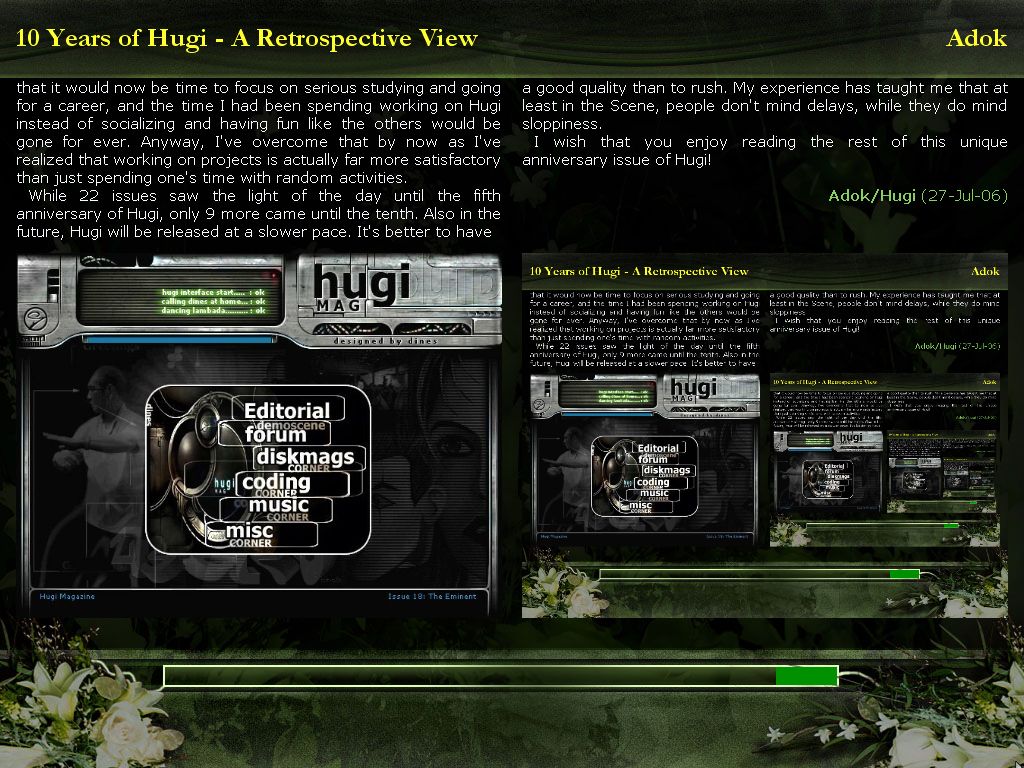10 Years of Hugi (Written By Adok/Hugi)
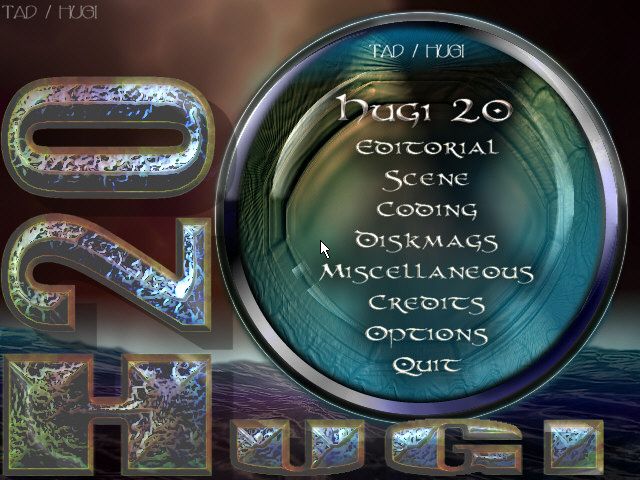
Today it's July 27th, 2006. On May 25th, 1996, the first issue of the Hugi Magazine was released. This was more than ten years ago. On this occasion it might be appropriate to take a look at the development of Hugi throughout all these years.
It all started around new year's eve 1996 when I received a letter from a German mail-swapper who called himself Kaktus. He contacted me as he had found my address in the German hobbyist PC magazine "Der PC-Heimwerker" and I had written that I was interested in exchanging "Scene-stuff". He sent me a
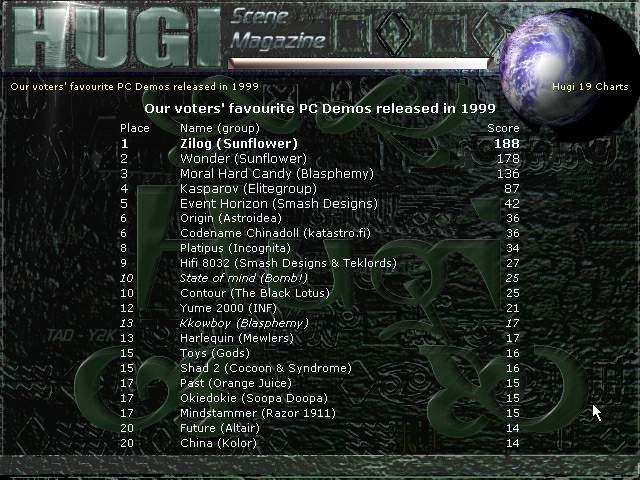
disk with a couple of freeware programs, and not only that - he also included a letter in which he wrote that he would like to start a new German-language diskmag and was looking for somebody to code an engine for him. This was no big deal for me as I had already programmed a text browser short before that. So one weekend, I coded up a simple but working diskmag engine in Quick Basic and sent it to Kaktus. To my surprise, he not only accepted the engine but seemed to have so much trust in my abilities that he immediately made me co-editor of the magazine - a challenge which I was ready to take as I had already gained experience at mag-making by editing several school magazines. From now on, Kaktus and I would be the two editors of a new disk magazine which, following Kaktus' idea, was going to be called "Hugendubelexpress" or short "Hugi". The concept of this magazine was vague. In early announcements and adverts, Kaktus called Hugi "the diskmag for people new to computers". As a matter of fact, the contents of the magazine were shaped by the interests of its contributors. The first issues mostly covered hardware, software, programming (Basic, Pascal, C, Assembler, Logo and some other languages) and "real life" stuff, which back then primarily equaled stories about everyday life at school. When Hugi #1 was released, Kaktus was 16 years old, and I was only 12. Most contributors were about our age, with some notable exceptions such as LeidPen, who was retired, or Bücherwurm, who had already graduated from university and was working in the chemical industry.
I created the graphics for the first two issues myself. With the next few issues, Kaktus and Karma Sutra, a Swiss teenager who later joined the (not really well known) German Demo group Kryst as a graphician, helped me. Since we had hardly any musicians among our swap partners, most of the background music was taken from mod-collections. I recall that one early issue of Hugi featured a background tune by Jester of Sanity, for example. I still remember somebody commenting on the first issue: "The only good thing about that mag is the music!" - Well, we developed.
Many diskmags died already after two or three issues, but we took our work on Hugi seriously and so it persisted. The number of contributors was more or less steadily growing, just like the
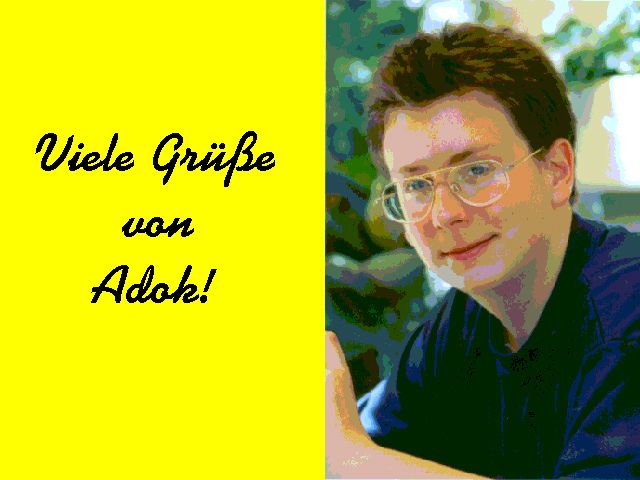
amount of texts per issue. While the first issue had about 400 kbytes of texts, the sixth already had more than 600 kb, and the ninth had more than 800 kb. With the eleventh issue, the 1-MB mark was exceeded. That was important for psychological reasons. My role models were the famous PC demo scene magazine Imphobia and the German PC diskmag Cream, both of which featured more than one Megabyte of articles per issue. For me, the kilobyte count always mattered more than the number of articles. I thought it would be better to have a few longer articles than loads of short ones. You might find some counterarguments against that philosophy, but as a matter of fact, most of the time I didn't even count the number of articles of an issue.
Another thing I considered of eminent importance was the quality of the language. The ideal diskmag should be devoid of grammar and spelling errors. Of course that's an ideal which is hard to achieve, but I tried my best at least to avoid the most obvious mistakes. Later, when Hugi was released in the English language, this also included the aspect of an elaborate vocabulary. In this respect, the Amiga diskmags ROM and Generation served as role-models for me.
Hugi #5 featured a new text browser, which was in text mode but nevertheless featured smooth scrolling. This had been the result of me playing with some VGA hardware registers which I had found about in a book.

Hugi #6 was the first anniversary issue, released exactly one year after the first edition. With its flowers in the menu picture, it bears some resemblance to the issue you're currently reading (#32). Hugi #6 featured a new engine which I had created using Borland C++ and was in SVGA (640x480, 256 colours). VESA 1.2 was required to run it. On my Windows XP configuration, it works fine, but unfortunately I haven't been able to make a screenshot pressing the 'Print Screen' key; it didn't work. The graphics were created by me again using some MS-DOS based painting program which was very popular back then and whose name I no longer remember, plus Micrografx Picture Publisher. IMHO they look quite good.
This engine was also used for issues 7 and 8. For Hugi #9, which was released in December 1997, I developed a new engine, this time based on VESA 2.0. While in my previous engines the menu and the text browser had been two separate programs (the menu called the text browser after the reader selected an article), now the menu was just a special text containing hyperlinks to the other articles. VESA 2.0 was required for the smooth scrolling inside the mag. I also used MIDAS Sound System for the first time - yes, I know, not a good choice, but at least now the Hugi engine no longer had to call an external terminate-and-stay-resident program in order to play the background music... The (anime-style) graphics came from Mr. SEQ, who had also composed the background music for this issue. I was very happy at Hugi #9 because it looked and felt far more demo scene-like than the previous issues. In fact Mr. SEQ was a member of the c64 Demo group Cream in those days (I guess it's just a coincidence that this group the same name as the German PC diskmag). He had also joined the German group NoLogic the founder of which, Black Shadow, was one of the most prolific (and entertaining) writers for Hugi back then. Some other early supporters of Hugi I perhaps ought to mention here are Toxo, Scorpe (also a c64 Scener - not only back then, but even today), Muffin, Schnurfel, Jabberwocky, DataSUN and of course Helmut Schida, a Viennese author who was supporting every (German) issue of Hugi with his poems and short stories.
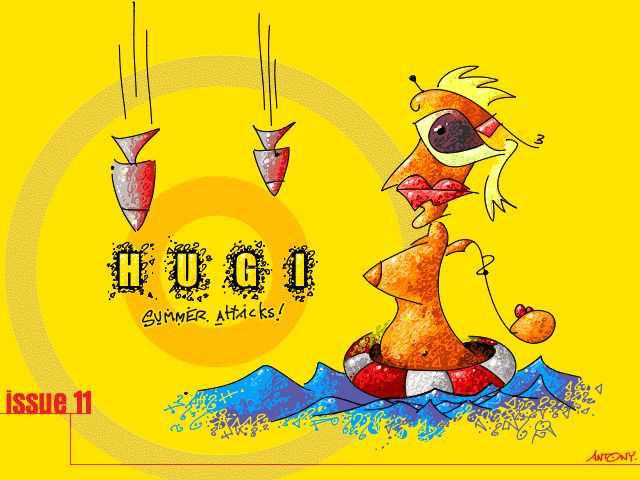
The great step forward came with Hugi #11, which was released in June 1998. While we had already had a small English section in Hugi #9 (mostly containg articles from a failed diskmag project, which had been sent to me by its would-have-been-main editor, Mercator of Ooze Labs) that hadn't spawned much feedback, Hugi #11 was a radical change of concept - the majority of the articles were now in the English language. This was possible because Kaktus had left the staff after Hugi #10, and so I was the only (main) editor of Hugi from now on, which gave me
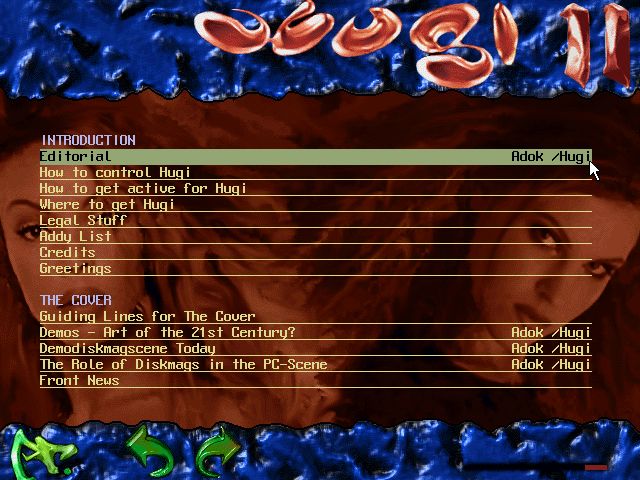
more freedom for applying my own ideas to the magazine. If you read Hugi #11, you might get the impression that I was a bit timid, wondering whether the international demo scene would accept us; yes, I was, for I had always perceived Sceners to be harsh critics. But surprisingly, Hugi was accepted well, and if you read my editorial in Hugi #12, you'll see that my tone was already far more self-confident. I think it was my philosophy of quantity and quality that made Hugi become so successful instantly. As a matter of fact, there was a vacuum in the international (demo scene related) diskmag scene back in those days. Officially Imphobia was not dead yet, but the last issue had been released in August 1996. The other mags weren't remotely as big as Imphobia. I tried to give my best to make Hugi a worthy successor to Imphobia.
In the next 2-3 years, I spent a lot of time on IRC motivating people to write articles for Hugi, to fill in the charts, to send me news, to spread the word. I also wrote a lot of articles myself - usually 20 % of the articles in each issue were written by me. "An article a day," was my motto in some periods. Fortunately, I had no problems at school, and so every day plenty of time remained to invest for Hugi. In the vacations, I didn't travel abroad as I had used to do before starting Hugi, but I spent all the day working on the magazine and communicating with other staff members and contributors. I completely neglected my social contacts outside the Scene; I almost only "talked" to other people online or via mail. It might have been a good idea to visit demoparties to get an even better picture of the Scene and the Sceners, but I didn't think of doing so for a long time; as a matter of fact I visited my first demoparty (Fiasko) only in 2000 when the climax of Hugi's success was already beginning to decline again. As a matter of fact I had a lot of contacts in the Scene over the Internet, but hardly any truly human, personal relationships to them, if you understand what I mean. (Though there have been some exceptions - e.g. ps spent a couple of days at my home during his world tour '99 and I showed him a bit of Vienna.)
Hugi #11 basically featured the same engine as #9 and #10; there were only some minor changes. E.g., the smooth scrolling had been replaced by cross-fading, and MIDAS by Indoor Music System. None of the three issues with that engine, however, works under my current configuration; for Hugi #11 I created a new version some years ago, which is based on the engine of Hugi #17 and fortunately works very well under modern Windows XP.
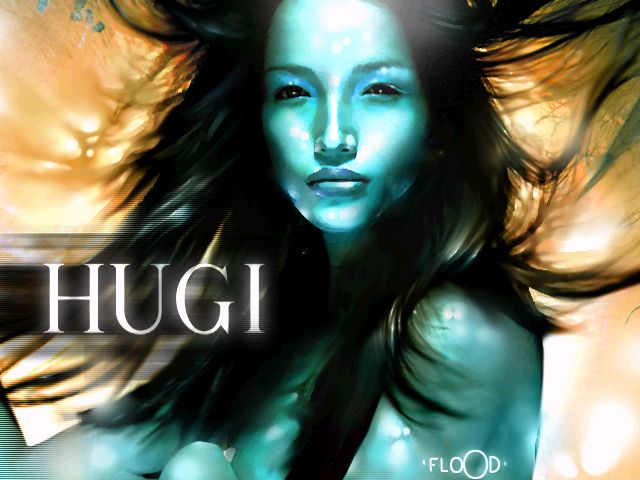
Soon after the release of Hugi #11 I got feedback from Street Raider of Deep, Deep Trouble Entertainment. Street Raider was the person who had developed the engine for the Russian diskmag Hacker and he offered that Hugi could also use that engine from now on. It had some cool, new features such as embedding images inside the articles. Without hesitating much, I accepted. From that day on, I no longer coded the engines of Hugi myself, but fully focused on writing, editing and organizing.
I must not forget to mention the person who actually
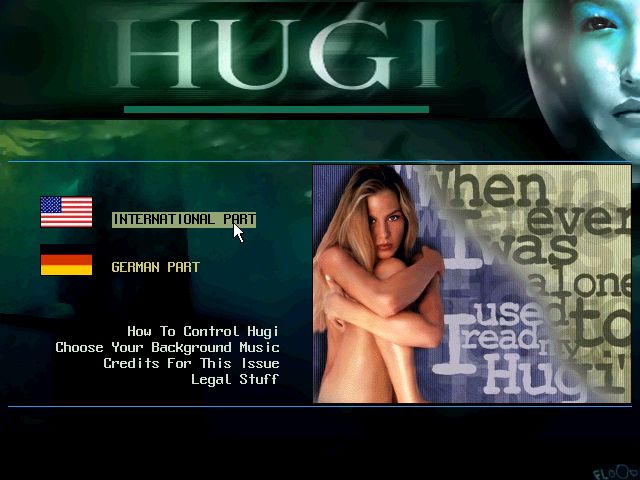
convinced me of transforming Hugi to an English language, demo scene related disk magazine. It was Salami of Ethos9 and Nothing. I'm grateful for his trust in my abilities, for his encouragements and for his real help with improving the engine of Hugi #11. I don't know if Hugi would have developed this way without his moral support. I must also thank him for sponsoring the domain hugi.de several years, which, unfortunately, meanwhile no longer belongs to him (and now points to a website that is not related to the Hugi Magazine at all).
It's difficult to say how important the hosting of the Hugi Size Coding Competitions was for the Hugi Magazine's story of success. I posted the rules of the first compo to related Usenet groups and websites someday between the releases of Hugi #10 and Hugi #11, when the Hugi Magazine and I were still virtually unknown outside the German speaking countries. I remember having been afraid that nobody would be interested in participating in the compo. What a surprise when I got "bombed" by people from all over the world, and in the end more than 80 (!!) people had submitted working entries for this compo! A similar competition in the Pain Magazine, which was already more known in the world scene than Hugi back then, had only attracted about 30 participants. (In case you wonder - yes, that had been the competition in which I won first place.) Maybe the compo also made people aware of the Hugi Magazine. As a matter of fact, one person who would later play an important role for the development of the Hugi Magazine first participated in the compos: Chris Dragan. Another man who first contributed to the compos, later to the magazine was TAD. There were several more Hugi Size Coding Competitors who later also wrote articles for the mag - e.g. Bonz, Boreal, and Sniper.
In any case, 1999 was the peak period of Hugi. The magazine grew so popular in the Scene over night that soon, many people would send me articles without being asked for support. Five issues were released in that year (#14 to #18), plus a Russian edition of #16. There were three milestones in that year following one another: With well more than 2 MB of articles, Hugi #16 (July 1999) was the biggest issue ever released. Hugi #17 was the issue that took the shortest time to create: It was released in August 1999, just a month after the previous one; nevertheless it had 1.4 MB of articles. Finally, Hugi #18 (December 1999) was the first issue that featured the diskmag engine by Chris Dragan which Hugi is still using nowadays. It was first developed exclusively for Hugi, but later Chris decided to
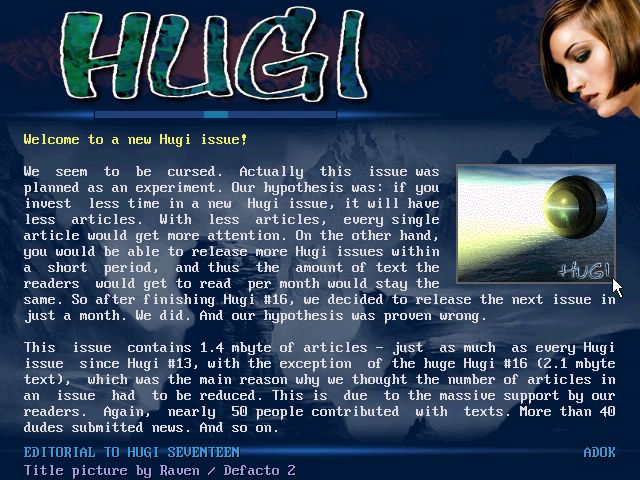
make it freely available at his homepage and therefore gave the engine its own proper name: Panorama. Actually there are some differences between the engine of Hugi #18 and the current issue; not only have some bugs been fixed and some features be added, but the file format is slightly different. That's because these days Hugi is actually using Panorama 2, for which the complete code was rewritten from scratch.
If you read the minimum requirements for Hugi in useguide.txt, you'll probably be surprised: It's
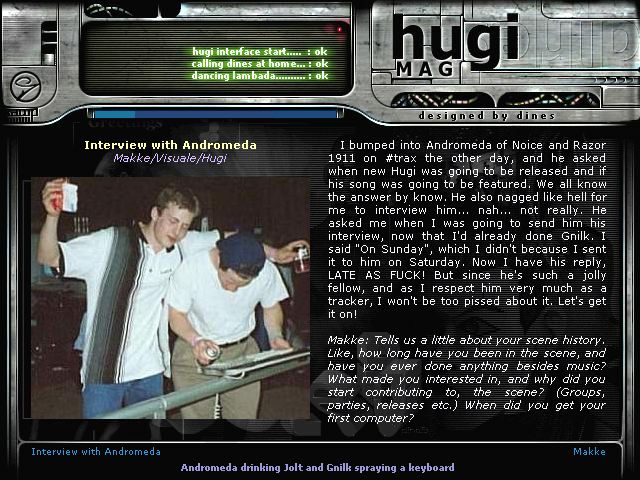
- Pentium 120, - 32MB of RAM, - Graphics card with 2MB of onboard memory, - DirectX 5.
Yes, even today Hugi would still be working on such a machine - although it would be rather slow unless you turned the music off or used a module with a low number of channels. Actually that shouldn't come as a surprise - why should a diskmag be demanding more CPU power?
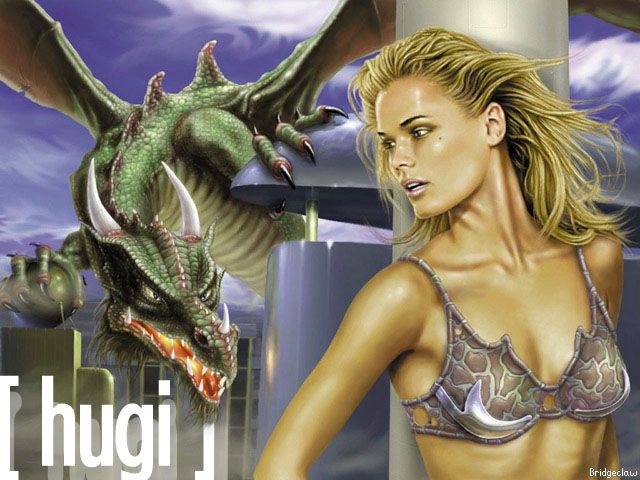
Apart from the diskmag, a text-based newsletter (similar to DemoNews or Demojournal) was released from September 1999 to July 2000. In total, 38 issues of HugiNews were released, but then it was stopped since I considered it to be obsolete; Orange Juice, which was updated every day, was a better source for news in my opinion back then.
A German section remained inside Hugi until #17. Its nature was slightly different from the original "German Hugi", since it was also more demo scene-focused. Then I made an attempt at
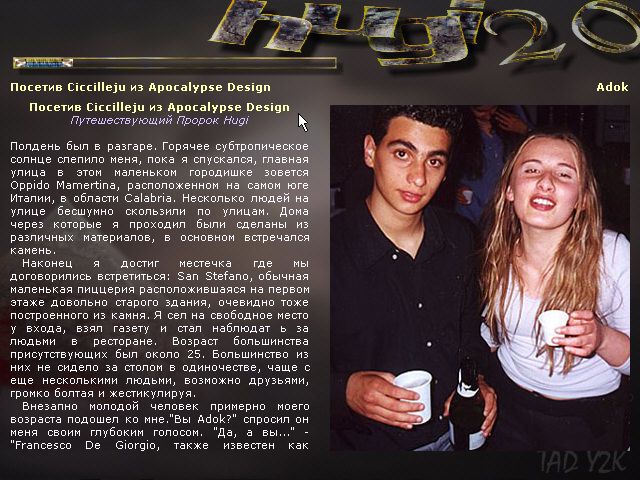
reviving the "original" German Hugi by creating Hugi.GER, but it failed as the people had changed and had lost touch with each other. Hugi.GER was first stopped after #3; later due to piccolo's commitment, two more issus were released, but they also failed to find a large readership.
Until #31, 12 issues of Hugi were translated to the Russian language (16, 18, 20, 22, 23, 24, 25, 26, 27, 29, 30, 31). One newsletter (HugiNews #28 from 26 February 2000) was translated to Turkish.
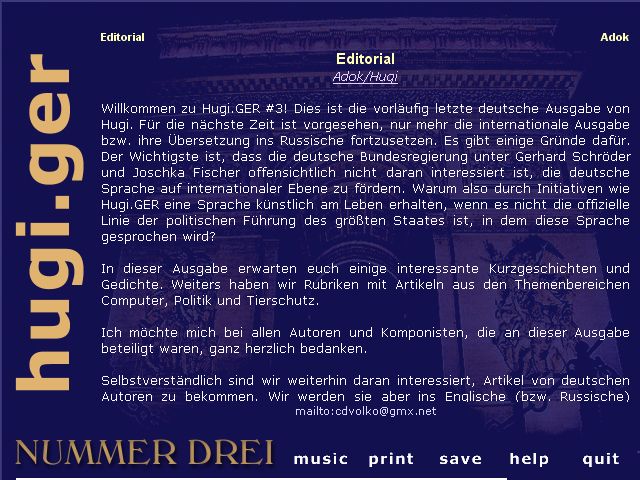
Other releases related to Hugi include Linux, BeOS and MS-DOS textmode ports of various engines, some text-processing utilities (Word2Panorama, PanoramaDTP, HTML2Hugi etc.), e-books of my programming tutorials for beginners, the mags.faq (introduction to diskmags for new Sceners and those who want to improve their knowledge), photos collections, bonus (sourcecode) packs, and, most importantly, two Special Editions: Coding Digest and Hugibox. While the latter (a musicdisk containg tunes from Hugi issues 11 to 28) didn't gain
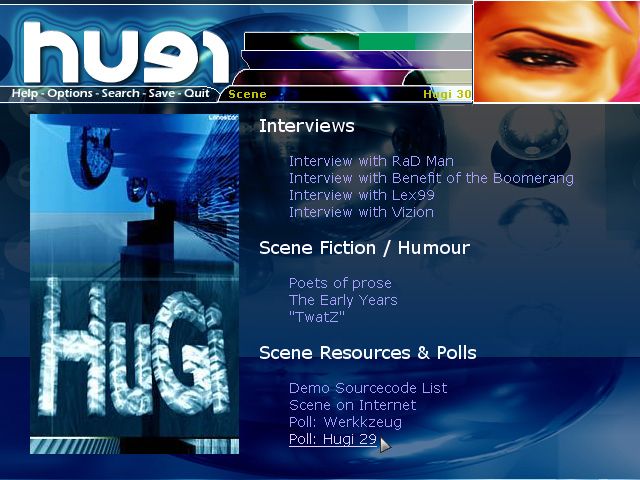
much popularity in the Scene, the former was very well acclaimed and some people consider it a reference for demo coding. It contains all programming-related articles from Hugi #11 to #27 - that's more than 5 MB of texts. Thanks to the search function, this digest makes it easy to retrieve the information you are looking for fast and easily.
Sometimes I was tired of making Hugi and wanted to stop it. This was especially in early 2000. I had simply overdone myself. Think about what I've told you about the year 1999 (three
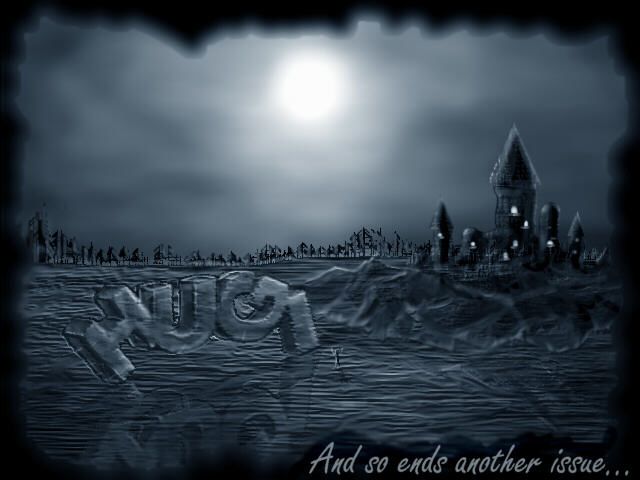
milestones in a row), then imagine what I must have felt like after that. Of course it's not possible to continue like this for ever. I vented out some of my frustration by producing a fake magazine in which I was allowed to break my self-imposed taboos, i.e. format the articles badly, make spellig errors, write total nonsense, flame people, etc. Well, as a matter of fact one of the slogans that appeared in Hugi #13 ("Hugi is Life") was really true for me, at least for a while. After graduating from high school, I had a kind of emotional break-down because I realized
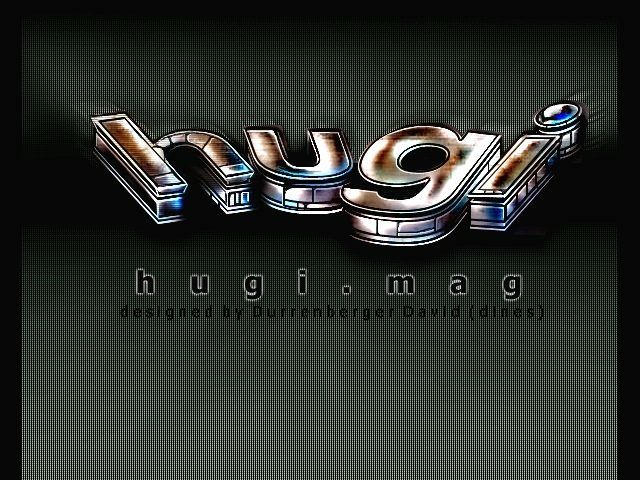
that it would now be time to focus on serious studying and going for a career, and the time I had been spending working on Hugi instead of socializing and having fun like the others would be gone for ever. Anyway, I've overcome that by now as I've realized that working on projects is actually far more satisfactory than just spending one's time with random activities.
While 22 issues saw the light of the day until the fifth anniversary of Hugi, only 9 more came until the tenth. Also in the future, Hugi will be released at a slower pace. It's better to have
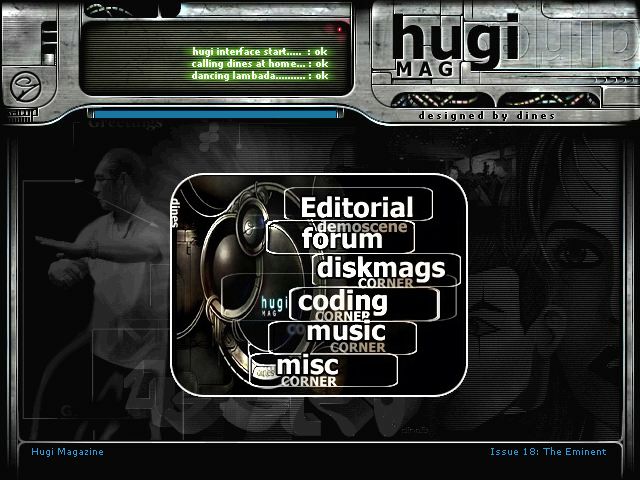
a good quality than to rush. My experience has taught me that at least in the Scene, people don't mind delays, while they do mind sloppiness.
I wish that you enjoy reading the rest of this unique anniversary issue of Hugi!
Adok/Hugi (27-Jul-06)
